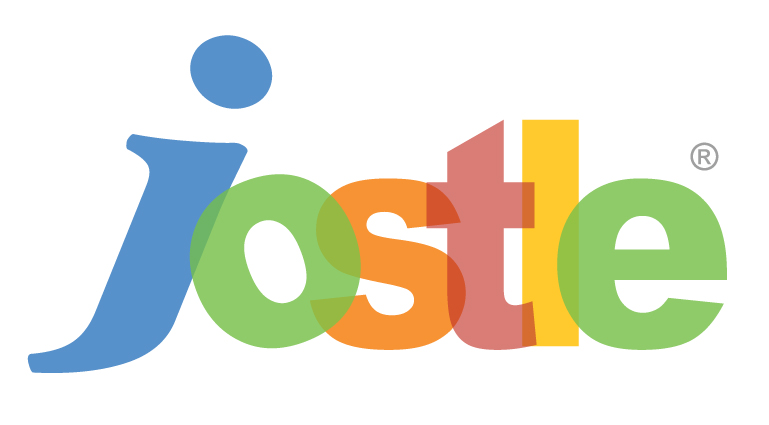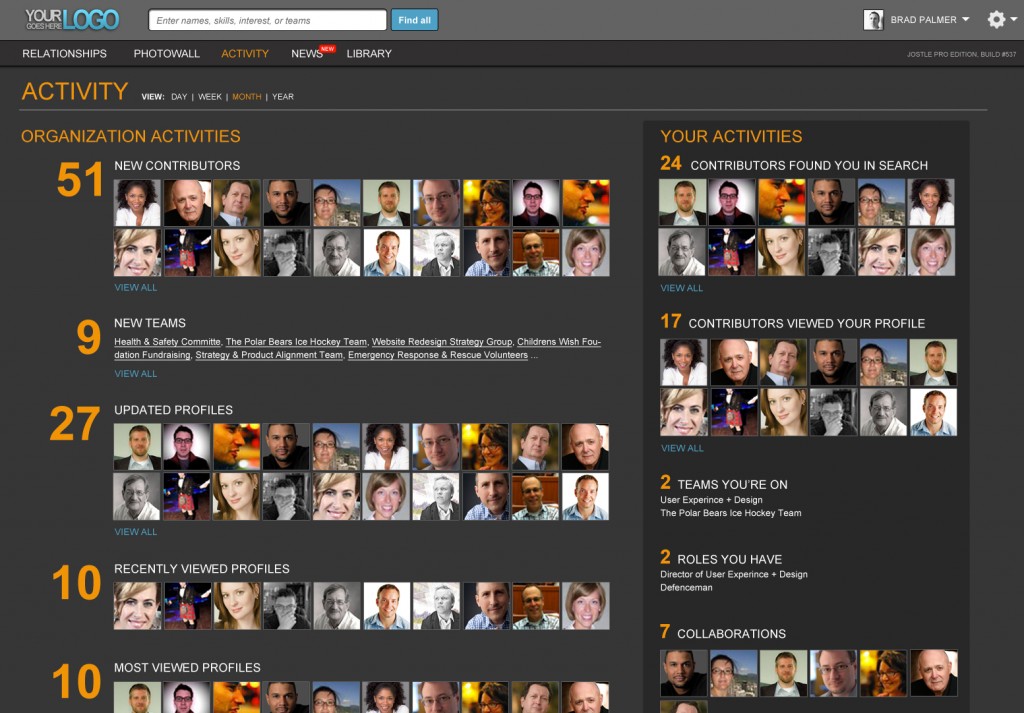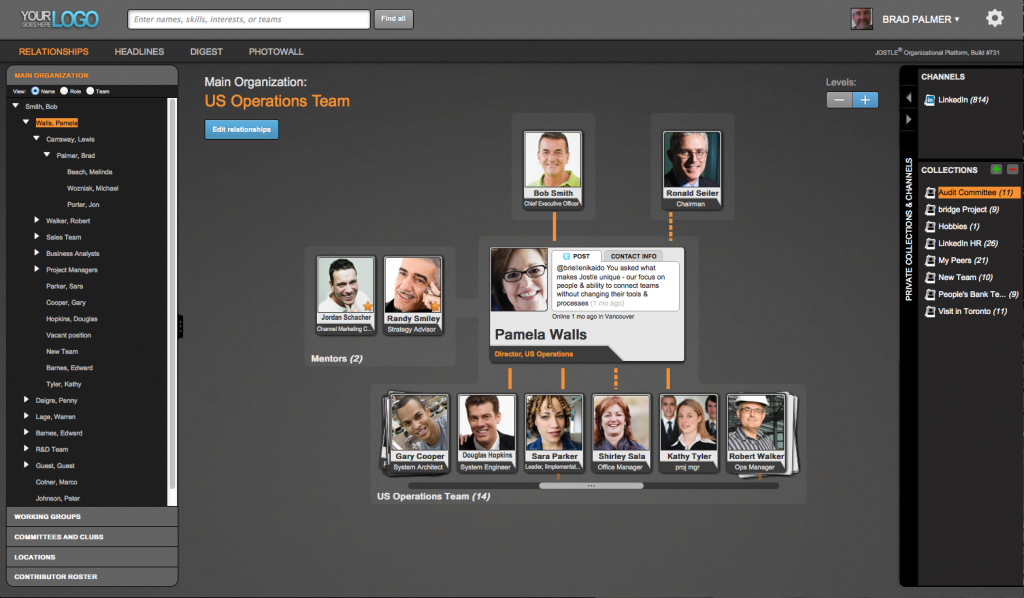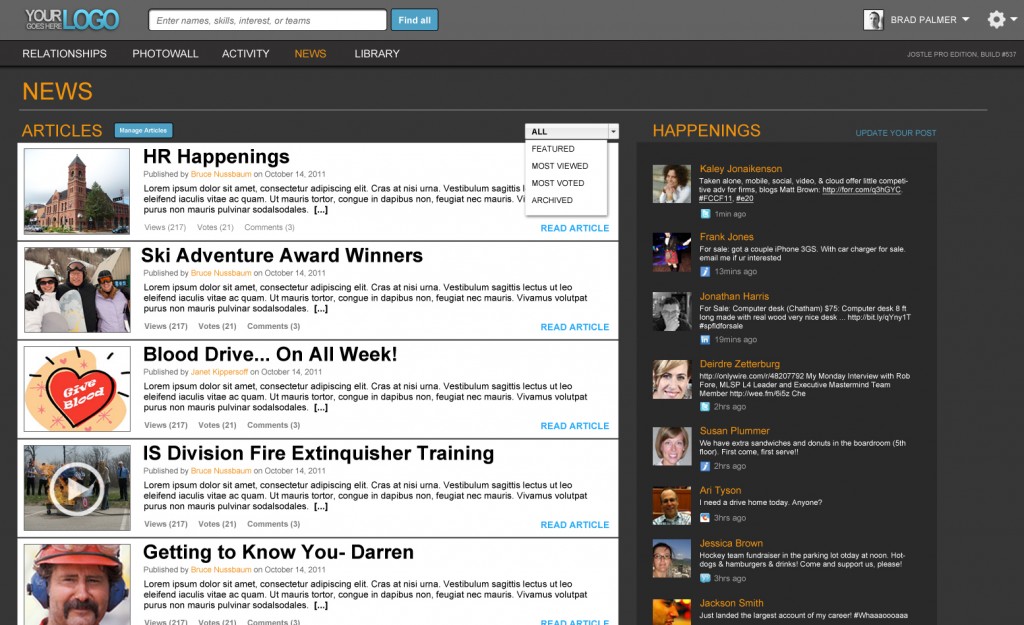
On Friday’s I’ll be reviewing a vendor in the emergent collaboration space and will provide an overview on that vendor which includes aspects from leadership and vision to technology and market focus. If you are vendor that would like to participate, please contact me (email is in the sidebar as is the twitter link). The goal of these posts is not to bash or praise vendors but to simply offer an objective view on what various vendors offer so that YOU can decide if they are a good fit for your business. Every post will cover the same elements for different vendors. If you have ideas or recommendations for other items to be covered in these posts then please let me know and I will consider them.
This week I’m taking a look at Jostle. Jostle is headquartered in Vancouver and currently has eight employees. Jostle is an organizational platform that connects people and aligns teams within companies and provides an alternative to traditional intranets. Jostle tells you everything about a person and where they fit within the organization such as who they are connected to, what projects they are working on, what teams they are a part of, it’s essentially a big picture view of the enterprise. I spoke with Brad Palmer, the CEO of Jostle.
Integration capabilities
Jostle integrates with Active Directory, Google Apps, Outlook, and other systems which store employee information. It also features a tight integration with LinkedIin and Twitter, and supports single sign on (SSO).
Support
The product itself is very simple and intuitive to use so support is usually quite minimal. However, Jostle does provide full support for free via email and also has a user forum but they have seen very little demand for either, again since it’s so easy and intuitive to use. Jostle also helps with “training the trainer,” which is all free of charge.
Pricing
The benchmark pricing is $6/user/month and ramps down from there depending on the size of the customer.
Maintenance & Upgrades
Jostle is pure SaaS and they provide a new build with additional features around 1x/week. This provides for continuous improvement to the product in a way that is easy for users to digest.
Overall direction and strategic vision for the company
The Jostle view is that enterprise social is still in its infancy. They believe the current generation of products is still struggling with the engagement and work focus part of collaboration. People are taking consumer web things and concepts and applying them to the enterprise, but the enterprise is different. There is a trust dynamic internally and work is done in teams, these things don’t apply to the consumer web. Jostle believes that whereas the consumer web is about peer-2-peer, enterprise collaboration is more about groups and teams. Jostle’s approach is not about adding new systems but connecting systems and making them more agile. Jostle believes that the problems we are seeing with Jive and SharePoint customers are items that Jostle has anticipated from the beginning. Jive for example spends an estimated $134,000 per customer to move data from their existing platforms into Jive and customers pay around 80% of this cost.
These types of tools are:
- Disruptive to implement, until you get mass collaboration this isn’t really effective.
- Create new mega-silos within the organization – a traditional enterprise software approach that never worked well in the past and certainly is not a good solution in today’s world, hard to put in place and implement.
- Change how people work instead of adapting to how they work.
- Challenge culture and decision making practices.
- Often encourage socializing that is not work relevant.
- Do not address generational issues in the workplace in a meaningful way.
As far as Jostle as a company goes, they are going to continue making things simple and focusing on their specific area of providing a big picture of the enterprise. Their approach encompasses three areas: the technical side with a huge emphasis on keeping things simple, integrated and turnkey, a strong emphasis on a slick and clean user interaction and experience, and finally, always keeping in mind that this isn’t about mass collaboration but on teamwork collaboration. Jostle is also going to be raising
Key differentiating factors from competition
Jostle is targeting medium sized companies that are frustrated with their traditional intranets. So far every medium sized company they have probed views their intranet as expensive to maintain, cluttered with information and generally unused. Many describe them as the “place documents go to die”.
Jostle sees three fundamental problems with traditional intranets: they require ongoing configuration, they are impossible to curate and they are content centric. According to Jostle vendors such as SharePoint compound these problems, providing a massive kit of features that is well beyond the capability and budget of most IT departments. Creating a usable SharePoint-based intranet requires a large ongoing expense and access to strong usability design expertise.
In contrast to traditional intranets, Jostle takes a strong people focus, builds in easy curation and limits the configuration to a few cultural choices to achieve simplicity and usability at a disruptive cost compared to traditional intranet approaches.
Relative to the emerging “social business” offerings, Jostle is unique in that it:
- Focuses on people, providing clarity around who is doing what.
- Creates a very simple and elegant people layer that operates above IT and systems.
- Unique focus around capturing culture and vibe of the organization through its News view that replaces traditional newsletters and bundles it in with more casual news and recognition that is presented in a user-specific and filterable way.
- Automates the generation and maintenance of email lists.
- Includes a patent-pending powerful search capability that is able to find people even names are misspelled, you know them through a nickname, or even an phonetic spelling.
- Providing agility without imposing change – teams can continue to use the point solutions they prefer, allowing the enterprise to become more app like in how it deploys software.
- Delivers agility and encourages collaboration without first needing to change how work is done or confusing decision making.
Customization
Jostle is not highly configurable and this is done by design, in fact really the only type of customization for organizations is the ability to add a logo. Jostle believes this is key to their ability to deliver superb usability. However Jostle is readily able to adapt to different kinds of company structures and cultures, including allowing organizations to control who gets to see information and build team structures.
Time to go live
Jostle takes around an hour to configure, including uploading existing team structures, etc.
Overall technology
Jostle runs on a naked browser and is coded in Java. The framework is GWT (Google Web Toolkit). Each company gets its own private space and is SAS 70 Type III compliant and data is double encrypted. Jostle also offers both Canadian and U.S. based hosting (to satisfy the Patriot Act). Nothing is on premise and there is nothing to download. Jostle also has two patents, one is on people search and the other is around the ability to sync to HR systems.
Industry/vertical focus
Only focused on internal uses (employees and trusted external contributors like customers and consultants). Currently Jostle is aiming to work with organizations that have between 250 and 1,000 employees.
Capabilities (customer, partner, employee collaboration)
Employees
My take
Chances are that you haven’t heard of Jostle yet as they are still up-and-coming. However, their approach is quite interesting. They aren’t a collaboration platform in the sense that you can’t do many of the things that you would expect a collaboration platform to offer such as microblogging, task management, group collaboration, document management, information sharing, ideation, or community development. Jostle is actually not really work oriented, meaning you wouldn’t use Jostle to get work done or complete tasks.
Jostle is an advanced people layer that gives you an overall blueprint and big picture for your organization. Think of your organization as a giant puzzle with random pieces scattered all over the place, Jostle is the platform that puts the puzzle together so that you can see how your organization is laid out and what the relationships between people at your organization is. Unlike the approach of most vendors which seek to become the sole collaboration platform inside of organizations, Jostle doesn’t care what platforms you use. In fact, Jostle acknowledges that your organization is most likely going to be using several platforms. So what Jostle does is allows you to link the various platforms together but not from an integration standpoint. Let’s say for example that you are looking for Sara in the marketing department, you find her and click on her profile. From there you can see where Sara sits within the organization, what groups she is a part of, what her relationships are, and what tools her team uses to collaborate (seen as links that you can just click on).
It’s really quite a very simple approach. I actually haven’t seen anyone go after the people layer like Jostle has and as I mentioned the concept and idea behind it is surprisingly simple. Of course there are challenges. For example, Jostle will not be able to provide with you really meaningful data or analytics around how your employees work since it allows teams to use whatever platforms they want to collaborate. Then, lets say you find Sara in the marketing department and see what tools she is using for her team, if you click on the links to be taken to her collaborative spaces you still don’t have access to them, so you can see them (and that is quite limited) but you can’t really take much action without messaging Sara and having her add you into her platform. Also keep in mind that Jostle is currently for organizations that don’t really exceed 1,000 employees but I can definitely see challenges if/when this scaled to organizations with 20,000 employees or 80,000 employees (but then again they might not even go after these large companies). The people layer is always a challenge as it is so dynamic, and this challenge is amplified quite a bit in larger organizations. Employees are always being hired and fired, changing roles, joining new groups, switching departments and locations, and are rarely static. Jostle pulls data from existing systems such as Active Directory so if your data there isn’t updated then Jostle won’t be either. In other words Jostle forces your company to be more accountable for your people, and if you’re not, then Jostle’s big picture view of the company will be wrong.
I think the people layer that Jostle has built is the best I have seen and is perhaps the most crucial part of collaboration, however it doesn’t allow you to take things to the next level by actually collaborating. Meaning if you were to use Jostle as a stand alone platform you will probably not be able to get things done that a “regular” collaboration platform will allow you to do. However, you can leverage something like Jostle with another lower cost or free solution such as Google Apps and that will create quite a powerful combination.
Jostle is going to be raising money and I’m quite sure they will be building out some additional functionality and features but don’t expect Jostle to go down the traditional route that most other vendors are taking, in fact Jostle will most likely take the opposite course, which is refreshing to see. The concept I mentioned to Jostle was building out a “traffic grid” for the enterprise where you can see green, red, and yellow depending on how information flows within the enterprise. If things are red within or between departments then you know that there is a problem with communication or information flow and you can address it.
It’s possible that within the next 12 months or so, a larger vendor acquires Jostle and integrates the people functionality into their own platform. Brad, their CEO, has a very interesting vision for his company and for the industry and I’m looking forward to seeing what they develop in the near future.
If you want to learn more about Jostle you can do so by visiting their site at www.Jostle.me or you can call Brad Palmer directly at 778-968-1556, make sure you mention this article so Brad has some context (and no I don’t get any type of affiliate or referral fees of any kind from any vendor).
Screenshots




Comments